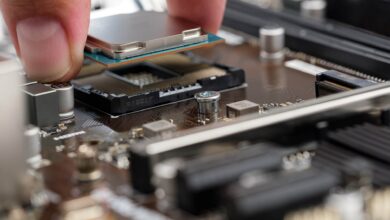
The world of cranial technologies is vast and complex, with advancements being made at an astounding rate. However, not all technology is created equal. If you’ve ever found yourself frustrated with the performance of your cranial devices or looking to upgrade, then this article is for you! We’ve compiled a list of the top 10 ways to improve bad cranial technologies so that you can stay ahead of the game and ensure optimal brain health.
Whether you’re interested in learning about proper usage techniques, different types of devices available on the market today, or how to choose the right technology for your needs – we’ve got it all covered here in this comprehensive guide. So let’s dive in and get started improving your cranial technologies today!
The Top 10 Ways to Improve Bad Cranial Technologies
1. Upgrade Your Hardware: One of the most effective ways to improve your cranial technologies is to invest in newer and better hardware. This doesn’t necessarily mean that you need to break the bank, but it’s important to keep up with advancements in technology.
2. Keep Your Software Up-to-Date: Just like upgrading your hardware, keeping your software up-to-date can greatly enhance the performance of your devices. Make sure you’re taking advantage of any updates or new releases from manufacturers.
3. Properly Calibrate Your Devices: Many people overlook the importance of calibration when it comes to their cranial devices. Proper calibration ensures that they are working at optimal levels and providing accurate readings.
4. Regular Maintenance Checks: It’s essential to perform regular maintenance checks on all of your cranial technologies, just as you would with any other piece of equipment or machinery.
5. Follow Instructions Carefully: Always read and follow instructions carefully when using any type of cranial device, whether it be for therapy or diagnostic purposes.
6. Seek Professional Help When Needed: If you experience difficulties with using or maintaining your cranial technologies, don’t hesitate to seek professional help from a qualified technician or healthcare provider.
7. Try Different Approaches: Don’t be afraid to try different approaches when it comes to improving bad cranial technologies – sometimes a fresh perspective can make all the difference!
8. Customize Settings for Individual Needs: Depending on individual needs, customizing settings on certain types of cranial devices can lead to improved results and overall satisfaction with their performance.
9. Use Accessories for Added Comfort/Functionality: There are many accessories available today that can enhance both comfort and functionality when using various types of cranial technologies – explore these options if needed!
10. Invest in Training/Education Resources : Investing time into training courses or educational resources related specifically towards use/maintenance/selection tips around cranial technologies could prove beneficial in understanding the technology better and help in improving their performance.

How to Properly Use Cranial Technologies
Using cranial technologies can be an effective way to improve your overall health, but it’s important to know how to use them properly. Here are some tips to ensure that you’re using cranial technologies correctly:
Firstly, always read the instructions carefully before using any cranial technology device. Make sure you understand how the device works and what its intended purpose is.
When using a cranial technology device, start with a low setting and gradually increase the intensity as needed. This will help prevent discomfort or injury from sudden or excessive stimulation.
Be consistent in your usage of cranial technologies. It’s recommended to use these devices daily for best results.
Ensure that the electrodes or pads used in cranial technology devices are clean and properly placed on your scalp. Poor electrode placement can lead to ineffective treatment outcomes.
Never share your personal cranial technology devices with others as this can lead to contamination and potential infection risks.
If you experience any discomfort or unexpected side effects while using a particular type of cranial technology device, stop immediately and consult with a healthcare professional before continuing use.
The Different Types of Cranial Technologies
When it comes to cranial technologies, there are a variety of options available. Each type has its own unique features and benefits.
Here are some of the most common types:
1) Cranial Orthotics – These are custom-made helmets that help shape the infant’s head over time.
2) Craniosacral Therapy – This is a hands-on approach that involves gentle manipulation of the bones in the head and spine to improve fluid flow and reduce tension.
3) Biofeedback – This technology uses sensors to monitor muscle tension in the head and neck, helping patients learn how to relax those muscles on their own.
4) Neurofeedback – Similar to biofeedback, this technology trains patients’ brains to regulate activity levels in specific regions related to anxiety, stress or other conditions affecting cognitive function
5) Laser Therapy- This is another non-invasive treatment option which stimulates blood circulation around affected areas aiding faster healing especially after surgeries
It’s important for individuals considering cranial technologies to consult with their doctor or specialist about which type would be best suited for their particular condition or situation.

The Pros and Cons of Cranial Technologies
Cranial technologies have both advantages and disadvantages that are worth considering before deciding to use them. One of the biggest advantages is that they can help correct various skull deformities, such as plagiocephaly or brachycephaly. This can improve a child’s appearance and prevent potential health problems.
Another advantage of cranial technologies is that they are non-invasive, which means no surgery is required. Instead, these devices work by applying gentle pressure to certain areas of the skull over time. This makes them an attractive option for parents who want to avoid more invasive procedures.
However, there are also some downsides to using cranial technologies. One common concern is the cost – some types of cranial helmets can be quite expensive and may not be covered by insurance. Additionally, wearing a helmet 23 hours a day for several months can be uncomfortable for children and challenging for parents.
Another disadvantage is that there may be limited research on the long-term effects of using these devices. While studies have shown short-term benefits in terms of correcting skull deformities, it’s unclear whether there could be any negative effects down the line.
It’s important to weigh both the pros and cons carefully when considering cranial technologies as an option for treating skull deformities in infants or young children. Consulting with medical professionals and doing thorough research beforehand can help make an informed decision about what will work best for you and your family.

How to Choose the Right Cranial Technology for You
When it comes to choosing the right cranial technology for you, there are a few factors to consider. First and foremost, it’s important to understand your specific needs and goals. Are you looking to improve your cognitive function or manage symptoms related to a neurological condition? This will help narrow down your options.
Another factor to consider is the type of technology available. There are several different types of cranial technologies, such as transcranial magnetic stimulation (TMS) and electroencephalography (EEG). Each type has its own unique benefits and drawbacks, so it’s important to do your research before making a decision.
It’s also important to consider the level of expertise required for each technology. Some may require specialized training or certification, so make sure you have access to qualified professionals who can administer the treatment safely and effectively.
Don’t forget about cost. Cranial technologies can vary widely in price depending on the type and duration of treatment needed. Make sure you have a clear understanding of what is covered by insurance, if applicable, and what out-of-pocket costs you may incur.
By considering these factors carefully and seeking advice from medical professionals when necessary, you can choose the right cranial technology that best suits your needs and budget.

Conclusion
There are various cranial technologies available in the market that can help improve your brain performance. However, it is essential to understand the different types of technologies and their pros and cons before choosing one.
Remember to properly use cranial technologies by following instructions provided by manufacturers or medical professionals. Always choose a technology that suits your needs and preferences.
By implementing the top 10 ways discussed in this article, you can further improve on these cranial technologies for optimal results. With proper usage and care, cranial technologies have immense potential in enhancing cognitive function and overall brain health.
See More: Successful Financing Business Tutorials






